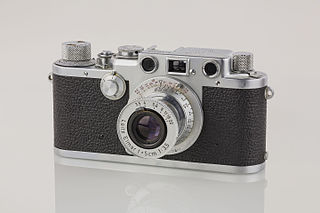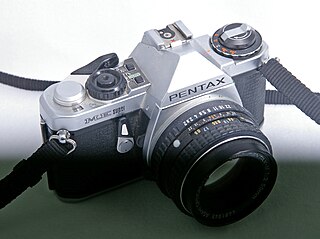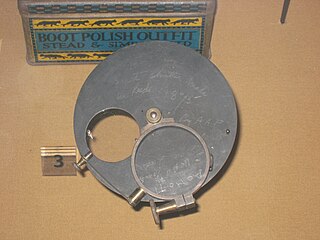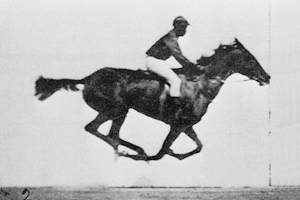

A rotary disc shutter is a type of shutter. It is notably used in motion picture cameras. Rotary shutters are semicircular discs that spin in front of the film gate, alternately allowing light from the lens to strike the film, or blocking it.


A rotary disc shutter is a type of shutter. It is notably used in motion picture cameras. Rotary shutters are semicircular discs that spin in front of the film gate, alternately allowing light from the lens to strike the film, or blocking it.
Rotary shutters are semicircular discs that spin in front of the film gate, alternately allowing light from the lens to strike the film, or blocking it. When blocking the light, the exposed portion of the film is advanced, and another, pristine frame is moved into position. The spinning disc then exposes the new frame of film. The nature of light-sensitive film requires a shutter to block the light and prevent "smearing" of the image as the film is advanced through the camera. Digital sensors do not require a rotary shutter, although some high-end digital cinema cameras do have them. Some rotary shutters utilize mirrors (or mirrored surfaces) so that when the shutter is in its "closed" position, light from the lens is redirected to a viewing system, allowing the camera operator to view, frame, and focus the image, exactly as the film sees it.
On more advanced cameras, the open portion of the shutter can be adjusted. This shutter setting is referred to as the "shutter angle". Adjusting the shutter angle controls the proportion of time that the film is exposed to light during each frame interval. The angle of the shutter forms a proportion to the time that each frame of film is exposed:
The primary reason that cinematographers adjust the shutter angle is to control the amount of motion blur that is recorded on each successive frame of film. A tight shutter angle will constrict motion blur. A wide shutter angle will allow it. A 180° shutter angle is considered normal.
So for instance, at 24 fps the "frame Interval" value is 0.04167 second ( = 1 / 24 ). Using an "exposure time" of 1/50 second gives a shutter angle value of 173°, very close to 180° (normal motion blur effect).
Tight shutters create a stuttering stop-motion animation look that has become popular in action and war films. In particular, tight shutters are used to capture particles flying through the air, such as dirt from an exploding mortar.
On most film cameras the shutter angle is changed by removing the lens and adjusting the shutter with a special tool. This cannot be done while the camera is operating. Some cameras such as the Arriflex 435ES can modify their shutter angle during the shot. This is sometimes referred to as an electronic shutter. An electronic shutter can compensate for the exposure change caused by a speed ramp without changing the aperture and affecting depth of field.
Other types of shutter adjustments, such as an out-of-phase shutter and a fluttering shutter, are also possible. Normally the film is held steady in the gate whenever it is exposed to light. Special shutter adjustments allow the film to be exposed while the camera mechanism is actually moving the film to the next frame. In the film Saving Private Ryan , cinematographer Janusz Kamiński used such a shutter adjustment to give his film the look of World War II newsreel photography. Previously, this effect could only be achieved by purposefully mis-adjusting the timing belt of the film advance mechanism in the camera. However, several manufacturers now provide accessories to electronically control the phase relationship of the shutter and film advance mechanisms. One such device is the Timing Shift Box available for the above mentioned ARRI 435 series.[ citation needed ]
Many video cameras also provide the ability to adjust their shutter. In most cases the camera does not have an actual mechanical shutter. Instead, this adjustment controls the amount of time that the electronic sensor collects light in order to create each successive image. Because electronic cameras do not need to mechanically advance film, it is possible for the shutter to be open for nearly the entire period of each successive frame. At 24 frames per second, it is possible to expose a frame for nearly 1/24 second, achieving longer motion blur otherwise impossible to achieve on film at sync sound speeds.
It is even possible for the shutter to be open for multiple frames, far beyond that possible with a 360° shutter angle. One example is the Sony PD170 where the shutter can be set as low as 1/3 second; accumulating light across 10 frames (at a frame rate of approximately 30 frames of 60 interlaced fields per second for the NTSC version of the camera and 25 of 50 for the PAL version)
The term electronic shutter is often used to describe the electronic process of controlling exposure time on a light sensor. The same term is also used in film cameras to refer to a mechanical rotary shutter which can adjust its shutter angle electronically while shooting.

While the vast majority of rotary shutters are naturally used on motion-picture cameras (as well as projectors), there were some still cameras that employed this type of shutter, notably the Univex Mercury rangefinder and the Olympus Pen F SLR. Both of these cameras were half-frame 35mm cameras (frame size 18 x 24 mm). The rotary shutter proved to be very simple to construct, accurate and reliable in these cameras. Though, in the case of the Univex, it resulted in a very strange "hump" on top of the camera to cover the shutter disc.

A single-lens reflex camera (SLR) is a camera that typically uses a mirror and prism system that permits the photographer to view through the lens and see exactly what will be captured. With twin lens reflex and rangefinder cameras, the viewed image could be significantly different from the final image. When the shutter button is pressed on most SLRs, the mirror flips out of the light path, allowing light to pass through to the light receptor and the image to be captured.

A camera is an optical instrument used to capture and store images and videos, either digitally via an electronic image sensor, or chemically via a light-sensitive material such as photographic film. As a pivotal technology in the fields of photography and videography, cameras have played a significant role in the progression of visual arts, media, entertainment, surveillance, and scientific research. The invention of the camera dates back to the 19th century and has since evolved with advancements in technology, leading to a vast array of types and models in the 21st century.

In photography, shutter speed or exposure time is the length of time that the film or digital sensor inside the camera is exposed to light when taking a photograph. The amount of light that reaches the film or image sensor is proportional to the exposure time. 1⁄500 of a second will let half as much light in as 1⁄250.

In photography, exposure is the amount of light per unit area reaching a frame of photographic film or the surface of an electronic image sensor. It is determined by shutter speed, lens F-number, and scene luminance. Exposure is measured in units of lux-seconds, and can be computed from exposure value (EV) and scene luminance in a specified region.

Motion blur is the apparent streaking of moving objects in a photograph or a sequence of frames, such as a film or animation. It results when the image being recorded changes during the recording of a single exposure, due to rapid movement or long exposure.
Robot was a German imaging company known originally for clockwork cameras, later producing surveillance (Traffipax) and bank security cameras. Originally created in 1934 as a brand of Otto Berning, it became part of the Jenoptik group of optical companies in 1999, and specializes in traffic surveillance today.

In photography, flash synchronization or flash sync is the synchronizing the firing of a photographic flash with the opening of the shutter admitting light to photographic film or electronic image sensor.
Film look is a process in which video is altered in overall appearance to appear to have been shot on film stock. The process is usually electronic, although filmizing can sometimes occur as an unintentional by-product of some optical techniques, such as telerecording. The effect is the exact opposite of a process called VidFIRE.
The science of photography is the use of chemistry and physics in all aspects of photography. This applies to the camera, its lenses, physical operation of the camera, electronic camera internals, and the process of developing film in order to take and develop pictures properly.

Time-lapse photography is a technique in which the frequency at which film frames are captured is much lower than the frequency used to view the sequence. When played at normal speed, time appears to be moving faster and thus lapsing. For example, an image of a scene may be captured at 1 frame per second but then played back at 30 frames per second; the result is an apparent 30 times speed increase. Similarly, film can also be played at a much lower rate than at which it was captured, which slows down an otherwise fast action, as in slow motion or high-speed photography.

In photography, a shutter is a device that allows light to pass for a determined period, exposing photographic film or a photosensitive digital sensor to light in order to capture a permanent image of a scene. A shutter can also be used to allow pulses of light to pass outwards, as seen in a movie projector or a signal lamp. A shutter of variable speed is used to control exposure time of the film. The shutter is constructed so that it automatically closes after a certain required time interval. The speed of the shutter is controlled either automatically by the camera based on the overall settings of the camera, manually through digital settings, or manually by a ring outside the camera on which various timings are marked.

In photography and optics, a neutral-density filter, or ND filter, is a filter that reduces or modifies the intensity of all wavelengths, or colors, of light equally, giving no changes in hue of color rendition. It can be a colorless (clear) or grey filter, and is denoted by Wratten number 96. The purpose of a standard photographic neutral-density filter is to reduce the amount of light entering the lens. Doing so allows the photographer to select combinations of aperture, exposure time and sensor sensitivity that would otherwise produce overexposed pictures. This is done to achieve effects such as a shallower depth of field or motion blur of a subject in a wider range of situations and atmospheric conditions.
In photography, through-the-lens metering refers to a feature of cameras whereby the intensity of light reflected from the scene is measured through the lens; as opposed to using a separate metering window or external hand-held light meter. In some cameras various TTL metering modes can be selected. This information can then be used to set the optimal film or image sensor exposure, it can also be used to control the amount of light emitted by a flash unit connected to the camera.

High-speed photography is the science of taking pictures of very fast phenomena. In 1948, the Society of Motion Picture and Television Engineers (SMPTE) defined high-speed photography as any set of photographs captured by a camera capable of 69 frames per second or greater, and of at least three consecutive frames. High-speed photography can be considered to be the opposite of time-lapse photography.

Image stabilization (IS) is a family of techniques that reduce blurring associated with the motion of a camera or other imaging device during exposure.
The Arriflex 435 is a movie camera product line created by Arri in 1995 to replace the Arriflex 35-III line. The number reflects its position as a successor camera to the Arri III and the fact that it is designed for 35 mm film. The 435 cameras are specifically designed as MOS cameras, which means that they are conventionally considered to be too loud to record usable location sound. However, this also frees the camera up to be optimized for non-sync sound uses, particularly any filming which either doesn't require sound or shooting at non-sync speed, shooting in reverse, or ramping between different speeds. As such, its potential applications are widespread, and thus it is regularly used on music videos, commercials, second unit work on features, special effects work, and motion control, among other usage. Rival Panavision even owns more 435s for rental than Arri's own hire houses; Panavisions, however, can be converted to Pan-Arri 435s where they are modified to accept Panavision lenses and accessories. In recognition of the achievements of the 435 system, AMPAS awarded Arri a Scientific and Engineering Academy Award in 1999.

Sports photography refers to the genre of photography that covers all types of sports.
This article summarized the comparison of movie cameras.
Panavision has been a manufacturer of cameras for the motion picture industry since the 1950s, beginning with anamorphic widescreen lenses. The lightweight Panaflex is credited with revolutionizing filmmaking. Other influential cameras include the Millennium XL and the digital video Genesis.

Pixel Camera, formerly Google Camera, is a camera phone application developed by Google for the Android operating system. Development for the application began in 2011 at the Google X research incubator led by Marc Levoy, which was developing image fusion technology for Google Glass. It was publicly released for Android 4.4+ on the Google Play on April 16, 2014. It was initially supported on all devices running Android 4.4 KitKat and higher, but became only officially supported on Google Pixel devices in the following years. The app was renamed Pixel Camera in October 2023, with the launch of the Pixel 8 and Pixel 8 Pro.